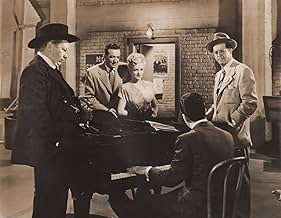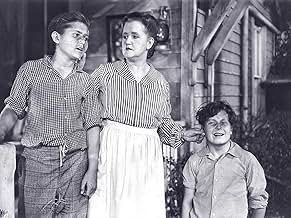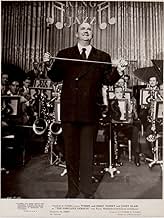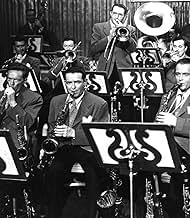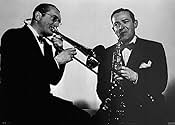PUNTUACIÓN EN IMDb
5,6/10
686
TU PUNTUACIÓN
Añade un argumento en tu idiomaThe Dorsey Brothers bandleaders' lives traced from childhood music insisting father to fame rise eventual split furthering careers propelling with their music.The Dorsey Brothers bandleaders' lives traced from childhood music insisting father to fame rise eventual split furthering careers propelling with their music.The Dorsey Brothers bandleaders' lives traced from childhood music insisting father to fame rise eventual split furthering careers propelling with their music.
- Dirección
- Guión
- Reparto principal
Reseñas destacadas
The movie tells the story of musician and bandleader brothers Tommy and Jimmy Dorsey (played by themselves), from their upbringing in Pennsylvania coal country to modest musical beginnings in small venues, to eventual radio success. Their fiery temperaments cause them to clash with each other often, eventually leading to a split and them each forming their own orchestras, after which they find even more success. Also starring Janet Blair as a childhood friend, singer, and peacemaker between the brothers, and William Lundigan as a composer and piano player for the band, as well as love interest for Blair.
Tommy the trombone player and Jimmy the saxophone player are excellent musicians but horrible actors. Thus the script focuses more often on the fictional characters played by Blair and Lundigan, neither of whom are much more compelling than the Dorseys. The viewer also begins to notice that not much of dramatic interest happens in the Dorseys lives other than them bickering like brothers do, so the only saving grace is the music, much of it performed by singers and musicians of the day playing themselves in cameos. I'm not familiar with many of them, but the music they perform is fine, and I'm sure will be appreciated by fans of the style.
Tommy the trombone player and Jimmy the saxophone player are excellent musicians but horrible actors. Thus the script focuses more often on the fictional characters played by Blair and Lundigan, neither of whom are much more compelling than the Dorseys. The viewer also begins to notice that not much of dramatic interest happens in the Dorseys lives other than them bickering like brothers do, so the only saving grace is the music, much of it performed by singers and musicians of the day playing themselves in cameos. I'm not familiar with many of them, but the music they perform is fine, and I'm sure will be appreciated by fans of the style.
THE FABULOUS DORSEYS is not fabulous - a B feature with a C-minus script and D-plus dialogue - but the music at least is enjoyable, as I'd expect from a picture starring not one but two big bandleaders.
Laying aside the rickety wooden dialogue and nonexistent love duo, the story is compressed but basically true: poor Irish mining family produces two talented musicians who don't get along, but rise quickly through the band business, start their own outfit, then inevitably break up. As a band nut I'd have liked to see mention of some of the name orchestras of the 20s including the Dorseys - Jean Goldkette? Freddie Rich? - or of Joe Haymes, a forgotten talent who sold Tommy his first band. But that's just me.
Janet Blair (like the brothers a Pennsylvania girl, and one-time vocalist with Hal Kemp's band) just lights up the screen every time we see and hear her, leading us to wonder just what she sees in a stuffed-shouldered cluck like William Lundigan. Other vocal highlights come from ex-JD singers Bob Eberly and Helen O'Connell and TD's then current crooner, Stuart Foster. Instrumental stars Art Tatum, Ray Bauduc and Charlie Barnet add heart to a jam session sequence. Paul Whiteman, gruff, fast-talking and positive, obviously liked playing Paul Whiteman, liaison between fiction and musical reality.
TD and JD are actually OK on screen - they weren't actors but one should not expect them to be. The fault there is with the mawkishly written dialogue that flops out of everyone's mouths. Their real personalities are visible, though toned down: Tommy's natural side-of-the-mouth cockiness, Jimmy's salty dignity of the veteran trouper. (In reality Tommy was profane and given to physical violence; Jimmy was quiet, decent but more than a little bitter, and both had long love-hate relationships with John Barleycorn.)
The real-life Dorseys - their music, their problems, their era - still await a full-dress Hollywood treatment before their names totally fade from the culture. It's easy to imagine, say, Ben Affleck and Ed Burns in the roles of TD and JD, complete with booze, broads, cuss words, flying chairs, and original orchestrations.
(PS: Those commenting about how over-the-top Mom and Pop Dorsey's Irish brogues were should understand that the actors playing them actually were Irish.)
Laying aside the rickety wooden dialogue and nonexistent love duo, the story is compressed but basically true: poor Irish mining family produces two talented musicians who don't get along, but rise quickly through the band business, start their own outfit, then inevitably break up. As a band nut I'd have liked to see mention of some of the name orchestras of the 20s including the Dorseys - Jean Goldkette? Freddie Rich? - or of Joe Haymes, a forgotten talent who sold Tommy his first band. But that's just me.
Janet Blair (like the brothers a Pennsylvania girl, and one-time vocalist with Hal Kemp's band) just lights up the screen every time we see and hear her, leading us to wonder just what she sees in a stuffed-shouldered cluck like William Lundigan. Other vocal highlights come from ex-JD singers Bob Eberly and Helen O'Connell and TD's then current crooner, Stuart Foster. Instrumental stars Art Tatum, Ray Bauduc and Charlie Barnet add heart to a jam session sequence. Paul Whiteman, gruff, fast-talking and positive, obviously liked playing Paul Whiteman, liaison between fiction and musical reality.
TD and JD are actually OK on screen - they weren't actors but one should not expect them to be. The fault there is with the mawkishly written dialogue that flops out of everyone's mouths. Their real personalities are visible, though toned down: Tommy's natural side-of-the-mouth cockiness, Jimmy's salty dignity of the veteran trouper. (In reality Tommy was profane and given to physical violence; Jimmy was quiet, decent but more than a little bitter, and both had long love-hate relationships with John Barleycorn.)
The real-life Dorseys - their music, their problems, their era - still await a full-dress Hollywood treatment before their names totally fade from the culture. It's easy to imagine, say, Ben Affleck and Ed Burns in the roles of TD and JD, complete with booze, broads, cuss words, flying chairs, and original orchestrations.
(PS: Those commenting about how over-the-top Mom and Pop Dorsey's Irish brogues were should understand that the actors playing them actually were Irish.)
The miracle in getting this film together was to get the Dorsey Brothers on the same sound-stage for this independent production released by United Artists. The feuding brothers who led two of the best and best known bands of the swing era was a story well known to the American movie going public.
Because of that and because their names and faces were so well known to the American public that certain parameters were put on the producers right from the start. That is the reason the brothers played themselves I'm thinking, despite the fact that as actors they were great musicians. It reminds me of The Jackie Robinson Story which was done a few years later where Robinson played himself and great athlete that he was, he just wasn't an actor.
Carrying the acting part of the film were Janet Blair and William Lundigan playing a singer and piano player whose lives were intertwined with the Dorseys. The only part of the film that was true was the breakup. The two brothers feuded constantly and were most competitive even as kids. As it is shown here, is exactly how the breakup occurred.
Also in the film were Mom and Pop Dorsey played by Sara Allgood and Arthur Shields. It is also true that they did grow up in the Pennsylvania coal mining country and that their father made them take music lessons as a way of escaping that life.
After leaving Paul Whiteman whose orchestra was the nurturing ground for an incredible amount of the musical talent in this country for a couple of generations, the Dorseys did strike out on their own with a joint band. And the split occurred exactly as it is shown on screen, they couldn't do it any other way, the story was part of swing lore. But as individual band leaders Tommy and Jimmy Dorsey scored their greatest success in the swing era. From 1935 when the split occurred until the end of World War II which was the end of the Big Band era, both orchestras were consistently in the top five of bands in any poll that was taken.
Jimmy was the quieter, more restrained and nicer of the brothers. Tommy's temper was legendary, but he had some of the best musicians around in his band and he ran it with an iron fist. One of the big parts of Tommy's story was his singer from 1940 to 1942 who when he went out on his own became probably the most famous graduate of either band. The parting with Tommy Dorsey was not a pleasant one for Frank Sinatra, although later on Sinatra gave Dorsey a lot of credit for the career he had. In fact he said that the way Tommy Dorsey played the trombone was whom he patterned his singing style after.
Jimmy had a couple of pretty good singers with his band as well with Helen O'Connell and Bob Eberly, both who had substantial careers, although not in the Sinatra league. Some five years after this film was made, the brothers did reunite.
Tommy died in 1956, a freak accidental death in his sleep as he regurgitated part of a heavy meal he just had and choked on it because of the pills he had taken. Sadly Jimmy Dorsey at the time of his brother's death knew he had a terminal throat cancer and he died in 1957. Their combined music will live on forever, providing enjoyment to millions.
And the music is the reason to watch The Fabulous Dorseys. This review is dedicated to those battling brothers who made so much good music together and so much better apart.
Because of that and because their names and faces were so well known to the American public that certain parameters were put on the producers right from the start. That is the reason the brothers played themselves I'm thinking, despite the fact that as actors they were great musicians. It reminds me of The Jackie Robinson Story which was done a few years later where Robinson played himself and great athlete that he was, he just wasn't an actor.
Carrying the acting part of the film were Janet Blair and William Lundigan playing a singer and piano player whose lives were intertwined with the Dorseys. The only part of the film that was true was the breakup. The two brothers feuded constantly and were most competitive even as kids. As it is shown here, is exactly how the breakup occurred.
Also in the film were Mom and Pop Dorsey played by Sara Allgood and Arthur Shields. It is also true that they did grow up in the Pennsylvania coal mining country and that their father made them take music lessons as a way of escaping that life.
After leaving Paul Whiteman whose orchestra was the nurturing ground for an incredible amount of the musical talent in this country for a couple of generations, the Dorseys did strike out on their own with a joint band. And the split occurred exactly as it is shown on screen, they couldn't do it any other way, the story was part of swing lore. But as individual band leaders Tommy and Jimmy Dorsey scored their greatest success in the swing era. From 1935 when the split occurred until the end of World War II which was the end of the Big Band era, both orchestras were consistently in the top five of bands in any poll that was taken.
Jimmy was the quieter, more restrained and nicer of the brothers. Tommy's temper was legendary, but he had some of the best musicians around in his band and he ran it with an iron fist. One of the big parts of Tommy's story was his singer from 1940 to 1942 who when he went out on his own became probably the most famous graduate of either band. The parting with Tommy Dorsey was not a pleasant one for Frank Sinatra, although later on Sinatra gave Dorsey a lot of credit for the career he had. In fact he said that the way Tommy Dorsey played the trombone was whom he patterned his singing style after.
Jimmy had a couple of pretty good singers with his band as well with Helen O'Connell and Bob Eberly, both who had substantial careers, although not in the Sinatra league. Some five years after this film was made, the brothers did reunite.
Tommy died in 1956, a freak accidental death in his sleep as he regurgitated part of a heavy meal he just had and choked on it because of the pills he had taken. Sadly Jimmy Dorsey at the time of his brother's death knew he had a terminal throat cancer and he died in 1957. Their combined music will live on forever, providing enjoyment to millions.
And the music is the reason to watch The Fabulous Dorseys. This review is dedicated to those battling brothers who made so much good music together and so much better apart.
The condition of the print that was transferred to DVD was just awful. This was no bootleg, either. It's the commercially available disc. That is a pity. Worse is the ham-handed acting and Irish accents think enough to cut with a dull knife. Even Barry Fitzgerald never laid it on that thick.
However... for me, it as all worth it to see Helen O'Connell sing "Green Eyes." Oh yes! So, I hold with many of the others' views: watch this for the music and skip the rest.
It would be a help if the print could be restored to a decent condition and a disc transfer made from that. However, the overall quality of the movie and, sadly, the lack of general interest in good music of the Swing Era, probably doesn't justify the expense.
However... for me, it as all worth it to see Helen O'Connell sing "Green Eyes." Oh yes! So, I hold with many of the others' views: watch this for the music and skip the rest.
It would be a help if the print could be restored to a decent condition and a disc transfer made from that. However, the overall quality of the movie and, sadly, the lack of general interest in good music of the Swing Era, probably doesn't justify the expense.
The true story of the rise of jazz/swing bandleaders Tommy and Jimmy Dorsey, The Fabulous Dorseys' appeal rests primarily on its basis in reality (the Dorseys portray themselves, in fact) and the many live performances recreated for the film. As for plot, well, it has none to speak of. The supporting cast is ornamental, and character development consists, for all but the last 15 minutes, of little more than establishing that the brothers don't always see eye to eye. Also, the film commands top honors when it comes to abysmal lip-synching and faux piano-playing. Nevertheless, it's clear that the point is to showcase the Dorsey's music and quell any gossip that may have been going around, at the time, about the tension between the Fabulous Dorseys, and on that level, this musical biography is pleasantly entertaining.
¿Sabías que...?
- CuriosidadesBob's concerto in the film is the "Dorsey Concerto", composed by Leo Shuken for the Dorsey brothers.
- PifiasAlthough much of the story takes place in the 1920's and 1930's, Jane's fashions, make-up and hair styles are straight out of the late 1940's when this picture was made.
- Citas
Mrs. Dorsey: There is only one thing worse than being Irish, and that's not being Irish.
- Créditos adicionalesOpening credits appear in the turning pages of a book.
Selecciones populares
Inicia sesión para calificar y añadir a tu lista para recibir recomendaciones personalizadas
Detalles
- Duración1 hora 28 minutos
- Color
- Relación de aspecto
- 1.37 : 1
Contribuir a esta página
Sugerir un cambio o añadir el contenido que falta

Principal laguna de datos
By what name was Los fabulosos Dorseys (1947) officially released in India in English?
Responde
